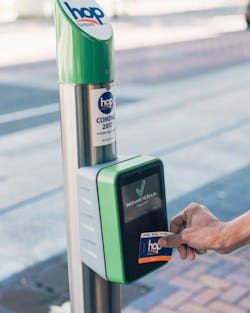Re-Inventing Electronic Fare Payment: TriMet Hop FastPass Works to Bring Transit to the 21st Century
With Hop Fastpass, Portland transit users can load value onto their account and then seamlessly and immediately use contactless payment devices across three transit agencies, allowing for fare payments on TriMet and C-TRAN buses, Portland Streetcar, MAX Light Rail, WES Commuter Rail and C-TRAN Vine BRT vehicles. All data and bank information is securely stored in the back end – not on the card itself. In fact, all bank data is tokenized and securely stored at the bank, bringing the entire system effectively out of PCI-DSS scope.
Hop allows users to enjoy a variety of benefits, including loss-prevention, auto-loading and a best fare guarantee. Each tap of a Hop card moves a rider closer to earning day and month passes, capping the fare once the price of a Day Pass and then Month Pass are reached, helping riders who can’t afford the upfront cost of a monthly pass. It’s currently the only system of its kind in the United States.
The Starting Line
TriMet’s journey to an electronic fare payment system began in 2010 with a thorough review of fare policies. To start, agency leaders looked at how fare was charged and collected across the tri-county system and initiated preliminary discussions with the technology and vendor community. General Manager, Neil McFarlane, wanted to overhaul TriMet’s antiquated fare collection system and bring it into the 21st century. By reducing the fare-paying public’s reliance on paper and coin currency, the agency could potentially reduce costs and increase revenue. It was critically important to incorporate smartphone technology to make fare available at a rider’s fingertips.
In 2012, TriMet took the first steps in simplifying fare collection. Gone were the transit zones that determined rates based on how far a rider traveled. Implementing flat rates further helped to take another step toward the future, which spurred more innovation and creative solutions for selling fares. McFarlane asked me to spearhead and guide the project through completion. We also brought on technical consultant CH2M to help navigate unchartered waters.
Mobile ticketing would come next. The timing couldn’t have been better for Portland-based moovel N.A. (previously called GlobeSherpa). The aspiring tech company had developed a mission to provide secure mobile ticketing for transit systems. TriMet became its first customer in what proved to be an advantageous partnership: The TriMet team knew fare collection; moovel knew mobile-app development.
The collaboration resulted in a first-of-its-kind smartphone application that could be used for bus and light rail. In 2014, the American Public Transportation Association awarded TriMet an APTA AdWheel 1st Place award for the development of the TriMet Tickets app and its seamless design and usability.
Technical Considerations: The Importance of Open Systems
By now, TriMet leadership and development teams were deep into the technical requirement for understanding what it would take to launch an electronic fare payment system. As the team inched closer to the next phase of development, they conducted peer reviews of e-fare payment systems in North America and abroad– specifically avoiding duplicating systems with technology that was already in existence for many years. Instead, they integrated several technology partners to create something that would be new, innovative and groundbreaking for riders.
TriMet CIO, Tim McHugh and I made an early commitment to adopt an open system that would allow easier integration with multiple third-party vendors. This was done in the belief that no single vendor could be the best at everything, so it would be necessary to contract with the best in class, in each of the chosen vendors’ specialties. To start with, real-time fare collection was a major priority — transactions that lasted mere milliseconds. INIT, a worldwide leading supplier of IT solutions for public transportation, was ultimately chosen to build the systems and application programming interfaces for the next generation of fare collection. As the ink dried on this partnership, Hop’s foundation was set.
An early objective — enabling Hop to serve as a tool that would allow riders to move effortlessly among various modes — was now a reality. The contactless fare payment plan would expand to include C-TRAN buses and rapid transit in neighboring Vancouver, Washington and the City of Portland’s streetcar system.
The Next Step: Development and Testing
Using methodical management and attention to design and detail, the Hop development team and associated partners launched into full-product development mode. Key priorities had to be considered, but one imperative remained — ensuring the system would be easy for riders to adopt as part of their daily transit routine. I refused to accept “no we can’t” from any one project team, vendor or otherwise. My mantra: There’s always a way forward. I also surrounded myself with some of the most talented minds in the transit industry and cultivated relationships with vendors who were flexible and motivated.
moovel had more than quadrupled in size since collaborating with TriMet on the mobile ticketing app. It had expanded its mission to include systems and technology that supported a seamless multimodal transit experience. It could now offer additional services that aligned with our e-fare goals, including account management that can be done via a smartphone app.
TriMet contracted with Ready Credit to build a retail network that will expand to more than 500 locations by early 2018. The Minnesota-based corporation is an innovator of prepaid products and specializes in transit solutions. Portland’s The Brigade design and technology studio to build a comprehensive, interactive and secure website for Hop Fastpass education and account maintenance and continued to build on an existing relationship with Germany’s Scheidt & Bachman to bring Hop-compatible tickets to vending machines.
The collaborative spirit TriMet fostered in its selection of vendors and consultants continued through product development with the Hop Fastpass project team. At times, the team would hunker down in a conference room and spend all hours of the day testing various aspects of the e-fare system, making the smallest of tweaks to streamline the user experience. They employed a systemic approach — one vendor at a time, one system at a time — to identify efficient processes that would deliver optimal results, and conducted countless use-cases of different customers using the system under a wide range of circumstances. This included analyzing and examining every aspect of every system — mobile apps, validators, backend software, website access via computers, point-of-sale hardware and software — the list goes on. The primary focus was always on the end user’s experience.
A New System for Portland Riders
In late 2016, 200 employees from TriMet, Portland Streetcar and C-TRAN became the first Hop Fastpass testers. Throughout the process, the development team used their feedback to fine tune and improve the technology. By February of 2017, it was time to invite transit users across the Portland-Vancouver region to give Hop a try. More than five thousand people signed up for the beta test. Their feedback was overwhelmingly positive and also led to improvements and adjustments that prepared Hop for mass consumption.
TriMet, C-TRAN, Portland Streetcar and the technology vendors who made Hop Fastpass possible teamed up for a public launch on July 17, 2017. Through precise guidance, the system launched on time and under the $34 million budget. Looking forward, continuous improvements are planned for the system, adding new features and expanding Hop’s reach to even more riders. Next steps include bringing TriMet’s LIFT paratransit system on board with seamless account integration, removing the need for these riders to tap.
As alternative mobility solutions grow in popularity, Hop will add additional modes of transportation, including possible integration of bike sharing and other services. Eventually, TriMet hopes to expand the Hop retail network to give riders more options and convenience, and ultimately make Hop a universal electronic fare payment system for transit agencies across Oregon and Southwest Washington.
About the Author

Chris Tucker
Director of Revenue Operations
Chris Tucker is the director of revenue operations at TriMet.
